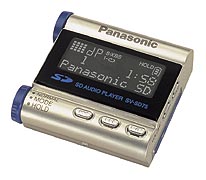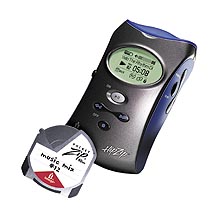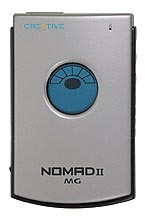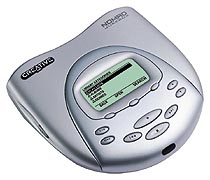|
|
|
Digital Music PlayersChoosing the perfect MP3 player (May 2001)
A mobile technology-savvy reader such as yourself will be very well aware of
all the new ways to carry music with you using digital formats, in particular the
ubiquitous MP3. My purpose here it is not to cover every possible alternative
when it comes to players and software. My intent is to take you through the steps
I went through in trying to find the perfect player for me, with an emphasis on
high-end, fully-featured players. As a former professional musician and recording
studio engineer, I was not interested in any device that was not up to pro
standards when it came to audio quality or control. My hope is that you will
benefit from my research and find the ideal device for you.
As there are many online resources available relating to the technologies of
digital music creation, I won't spend too much time in this area except where it
applies to my choice of hardware and software. There are, however, a few key
concepts that it will be helpful to discuss right at the top.
An important thing to know about digital music is that it is not a new
concept. Compact Disks all contain audio files encoded into the WAV format. These
files can be copied to a computer; however, they are absolutely huge--unmanageably so.
Computer users have been playing around with digital audio files in various
forms for as long as there have been personal computers. It wasn't until the
creation of our very high-quality sampling technologies, such as MP3 in the early
90's, that a viable, high-quality method of compressing these enormous files into
something that could be easily manipulated on a personal computer became
practical.
It's easy to become overwhelmed with all of the options presented to you when
you want to "rip," or sample, an audio file to your computer. Varying levels of
quality, represented by a range of sampling rates, a.k.a. bit rates, are
selectable, typically in the range of 96 to 192 Kbps. In general, anything above
128 Kbps is considered "near CD quality." This is highly debatable, particularly
if you come from an audio background. Personally, I feel that 192 Kbps offers the
perfect trade-off between audio quality and file size. The only downside to using
this bit rate is that it takes a bit more disk space on my computers and on my
handheld devices. Other considerations for selecting a bit rate include the type
of material being ripped. Orchestral music always benefits from a higher sampling
rate, whereas pop music usually sounds fine at slightly lower bit rates. I use
192 for everything, but you may find that you are satisfied with the more
space-effective 160 or 128 rate.
Though I did not plan it this way, the players I ended up with range from
matchbox-sized (Panasonic e-wear) to portable CD player-sized (Creative Nomad
Jukebox). I soon found out that size was no indicator of audio quality, though
functionality was increased as the devices grew. For example, the diminutive
Panasonic produced gorgeous sound—when used with any of my beloved Sony
headphones instead of the included Panasonic-branded clip-phones, that is. (See
sidebar for more about headphones). At the other extreme, the Nomad Jukebox blew
all the other devices away when it came to sound quality when plugged into my car
audio system.
I've eaten pieces of sushi bigger than the SD75. This incredibly cute little
unit is so Japanese it looks out of place on my desk full of "small" devices.
Miniscule, elegant, expensive products like this virtually never make it to the
US market. The Japanese want their tech as small and as powerful as possible,
even if it means the controls are so small as to be essentially indistinguishable
from each other.
And the less you get, the more it costs. The SD75 streets for a shocking
US$360-$380, though it does come well equipped with accessories. You get
hip-looking clip-phones, a 64MB Secure Disk card, a NiMH battery charger and AAA
cell, a USB external SD card reader (Windows only), an arm/wrist strap, a belt
clip, and a neck strap so you can wear it like a pendant. The headphone cord is
cleverly designed to be just long enough when worn on the arm or necklace style,
yet it comes with an extension cord for those who would rather wear it on their
belt or in a pocket.
So how does it sound? Through the supplied phones, very good to excellent.
Through any of my Sony phones, superb. Your MP3s are "transcoded" into secure AAC
files when they are transferred onto the SD card. Though the card is visible on
the Windows desktop, you should not write directly to it due to the draconian,
SDMI-compliant (Secure Digital Music Initiative) copy protection scheme. You
cannot, for example, insert the SD into another device and copy the songs from
it. They are "checked out" to that unique card only. At first, this bugged me,
but then I realized that I would never want to copy these songs from this little
wafer anyway. I'd just check out fresh copies from my computer.
As one of the three designers of the SD (SanDisk and Toshiba are the other
two), Panasonic has understandably committed themselves to SD-enabling their
entire line of personal electronic devices, including digicams, camcorders, and
more. Sony is doing the same thing with the secure variant of their Memory Stick,
the Magic Gate. Whether the American buying public will buy into this approach
remains to be seen. But the SD75 looks, feels, and sounds so good that you
probably won't care and will just buy the little cutie. www.panasonic.com or
800-211-PANA
Due to the mechanical requirements of the drive mechanism, Iomega's HipZip
music player is somewhat bulkier than others in its class. They made up for it
with excellent industrial design, with smoothly curving surfaces that fit the
hand perfectly. The controls are well-placed and feel like they are built to last
a lifetime, and the generous backlit display contains all the information you
could possibly want. If you saw a HipZip sitting on the captain's desk on Star
Trek, it would blend right in.
How's it sound? Wonderful! Full and rich (with decent phones, of course), this
unit's sound is a delight. You would not expect Iomega to take such care when it
comes to sound quality, but they did. It is the equal of any of the other models
I tested.
Thankfully, Iomega has eschewed copy protection completely in this device. In
fact, you don't even need to use any special software to get your music onto the
disks. Just plug the supplied USB cable into your Windows or Mac OS computer and
drag your MP3 or WMA (Windows Media Audio) files over to the disk. Boom, you're
done. You can also use your HipZip as a convenient data transporter for non-music
files if you like. As far as your computer is concerned, it's just an external
DOS-formatted disk drive. Iomega sells PC Card adapters and dedicated external
PocketZip readers to streamline things even further. If you really get into the
PocketZip thing, you'll probably want one of these. The HipZip costs US$250-$275
(street) and comes with two 40MB PocketZips, typically so-so headphones, a really
nice case by BodyGlove, and the full version of MusicMatch Jukebox. At press
time, Iomega announced their new 100MB PocketZip drives and disks, and that they
would ship a 100MB-compatible version of the HipZip in Q3 2001. www.iomega.com
or 800-MY-STUFF
If you are looking for elegant design, look no further than this little jewel.
The case is all silver matte finished magnesium with gray accents, and a
porthole-like round LCD panel that's a joy to look at. Unlike some models, the
branding is minimal and tasteful. Even the typography is top-notch. I find the
size to be just right: small enough to disappear in a pocket, large enough to
operate by feel alone. You could easily jog with this unit in your hand without
feeling weighed down. In the looks department, it's a slam-dunk winner.
But looks aren't everything. The Nomad II MG sounds superb. Crank it up and
it'll break up just a skosh on the top end, but you'd never want to listen to
music that bloody loud anyway. With 64MB internal memory and a SmartMedia slot
for up to 128 additional megabytes, capacity is excellent. Want more? Creative
Labs has released a special limited edition with a show-stopping 256MB internal
memory. Add in a 128MB (at press time, only Delkin Devices was shipping a 128MB
SM card) you get 384MB. At an average of one megabyte per minute of stereo music,
that's a lot of tunes!
Creative has taken the high road in the software department by creating
PlayCenter II, a full-featured digital music center for Windows that was designed
specifically for the Nomad line of music players. It offers high bit-rate MP3
encoding and complete control over your Nomad player or Nomad Jukebox (see review
below).
This player has a slot for SmartMedia memory cards, the same kind used in many
popular digital cameras. This is a mixed blessing. SM cards are expensive,
fragile, and of moderate capacity. I hate these nasty little data-wafers, but I
use them when I have no other choice. (See Digital Camera Magazine at
www.digicamera.com for more.) I accept them in the Nomad II MG because I
understand the need for small size. Delkin's new 128MB card works perfectly, but
it's expensive. WARNING: Do not use Olympus-brand SM cards in the Nomad or any
other music player. Olympus cards have proprietary software on them to facilitate
the creation of photo panoramas in Olympus digicams. If you insert one into a
Nomad's slot, the card dies permanently. I lost a perfectly good 32MB card this
way.
The Nomad II MG also has a built-in FM radio tuner from which you can record
directly if you happen to hear something you like. The Nomad can also serve as a
voice recorder for reminders, interviews, or impromptu jam sessions if you are
into that scene. The FM tuner uses the headphone cord as the antenna, so
reception can be spotty and inconsistent in fringe areas or when you are in
motion. Station presets can be saved on the Nomad or from the supplied PlayCenter
II software or the included SoundJam MP for Mac users. When you add it all up,
it's a versatile, impressive package. Pricing for the Nomad II MG is a little on
the high side at US$255-$290, and of course the headphones are a disaster, but
this is the state of the art in small digital music players and is worth every
penny. If you are a Mac person, this is the one you want. www.nomadworld.com or
800-998-5227
Unlike any other device that came before it, the Nomad Jukebox packs 6
gigabytes of storage into a unit about the size of a portable CD player. In
essence, it's a little Linux computer (don't be frightened; the ugly part is well
hidden) that is dedicated to storing, organizing, recording, and playing 100
hours of digital music.
Let's work with that concept for a moment. In addition to a standard headphone
jack, the Jukebox has two line outputs. They can be configured as either dual
stereo into four speakers or a synthesized, real-time surround setup with front
and rear speaker pairs. Cambridge SoundWorks (www.cambridgesoundworks.com) will
soon ship a rechargeable speaker/amp system with a custom mounting plate and
power fitting for the Jukebox—an ideal setup for boats, RVs, or apartments with
limited space. Speaking of vehicles, the Jukebox sounded infinitely better than
all the other units I tested when piped through my car's audio system. The
balanced line-level output is the reason, since headphone ports are biased for
high-impedance headphones and not high-quality audio components.
There is also a line-in jack for a self-powered (not phantom-powered) stereo
condenser microphone. Sony makes several stereo mikes that would be perfect for
this use. This rig will capture stereo recordings from a voice-quality 11Khz to
an amazing 48Khz sampling rate. The resulting files are true CD-quality (44.1Khz)
to DAT-quality (48Khz) stereo WAV streams. If you are a musician, you'll want a
Jukebox for this capability alone.
Serious digital music people will find many things to love about the Nomad
Jukebox. I like being able to offload all those MP3 files from my computer's hard
drive to save precious space. I use a Panasonic ToughBook CF37, a ruggedized
magnesium-shelled notebook computer about which I like everything except its puny
8GB internal drive. At this point, I have 762 MP3 tracks stored on the Jukebox,
with a little less than 2 gigabytes left for more. When I eventually fill it up,
I'll just delete the least interesting tracks and free up the space.
This machine uses four conventional AA NiMH rechargeable cells that are
charged in the unit whenever it is plugged in. Creative thoughtfully included a
second set of four cells for a total of 8 hours of continuous play time.
Other interesting features include a large, 7-line backlit display for easy
navigation, a parametric equalizer, and a "spatialization" feature. I've never
been very hot on parametric EQ. Originally designed to find specific frequencies
to cut or boost as needed in live concert sound reinforcement, they have an
unnatural sound to them that I dislike. I'd have preferred a good 10-band graphic
EQ instead. The simulated acoustic effects offered by the spatialization presets,
such as Hall and Cave, are also a bit on the artificial side for my admittedly
minimalist taste. I just leave this and the parametric feature disabled. Younger
ears may dig them, though.
The Jukebox uses the same excellent PlayCenter II software as the Nomad II MG,
so everything I wrote above applies here as well. Where it all comes together to
create some synergy is when you use the two Nomads together with your PC as your
Jobsian hub. Moving dozens of tunes from device to device is extremely simple and
very fast via full-throttle USB. Grab the playlist, album, or individual tracks
you want, hit the Transfer button, and a few seconds later you're out the door.
Speaking of Macs, the Nomad Jukebox ships with the full version of Casady &
Greene's excellent SoundJam MP ripper/player, or you can use Apple's superb
iTunes software since it supports Nomad devices natively.
Creative Lab's Nomad Jukebox is a monster product for the serious digital
music freak. It's got a big price tag (US$425-485 street) but an even bigger
satisfaction quotient. Even the headphones are somewhat less awful than the
others. www.nomadworld.com or 800-998-5227
Readers of this magazine may already have the perfect music player in their
possession. Any Pocket PC on the market can serve up MP3 and WMA files using the
built-in Windows Media Player. If you have a large CompactFlash card, you can
easily load and store many hours of music. The only downsides to using Pocket PCs
as music players is that it runs the batteries down in just a few hours and mass
CF storage is expensive. Nothing can be done for the first problem except to
carry spare power packs, but transcoding (there's that word again!) your MP3
streams into Microsoft's WMA streams can pack many more tunes into a smaller
space. I'm skeptical of Microsoft's claims of zero audio degradation from
transcoding into WMA, so I never do it. Then again, I have stacks of fat CF cards
lying around from my work at Digital Camera that I fill with whatever MP3 streams
I like.
The sound quality from my Compaq iPaq 3650 is good to very good. It would get
a better rating if it did not skip and pause occasionally, but considering that I
may also be using the unit to balance my checkbook or read my email while
listening explains the processor load that causes such hiccups. Again, headphone
quality is the key factor here. Don't skimp. If you paid less than US$30 for
them, you have loser phones. www.compaq.com/ipaq or www.pocketpc.com
Digital music players are far more than just another way to truck your
personal tunes around. This is a whole new way of living with music, a more
flexible and customizable approach than any that have come before. (Remember DAT
machines?) The advantage of having no moving parts means extremely high
reliability for digital music players, while the semiconductor and/or magnetic
memory storage technologies lighten our load and eliminate the worry of tape wear
or CD scratches. The CD becomes the "golden master" from which you rip your music
to whatever device pleases you. For music of fleeting interest, you can eliminate
the CD entirely, download the stream into your computer, then trash it when you
can't stand Who Let The Dogs Out? anymore.
What did I settle on? I already owned the iPaq 3650, so that didn't count. I
almost picked the Panasonic SD75, but the tiny controls bugged me after a few
days, and the Big Brother-feel of the required SD transcoding concerned me. The
HipZip was a serious contender in every way, but the more elegant size and large
capacity of the Nomad IIMG swayed me into the Creative camp. Once there, I found
that I could not part with the Nomad Jukebox either. With Creative PlayCenter II
on my notebook running as a hub, the Nomads form such a well-oiled system that I
just could not put them back into their boxes. And in the event that I switch
back to a Mac, these Nomads are totally Mac-compatible.
If size and capacity are important, get a Nomad II MG. If low media cost
matters, get the Iomega HipZip. They both rock.
|


 That was enough for me. I had to have one. I was using a PowerBook G3 at the
time, so I downloaded the free iTunes, plugged in a Nomad II MG, and it all
worked pretty much as advertised.
That was enough for me. I had to have one. I was using a PowerBook G3 at the
time, so I downloaded the free iTunes, plugged in a Nomad II MG, and it all
worked pretty much as advertised.
 Weighing in at about one pound, you would not want to jog with a Nomad
Jukebox, even though it has a five minute skip buffer to keep the music streaming
happily. For just about any other kind of environment, though, the Jukebox rules.
One of these, in conjunction with an amplifier and speakers, can serve as your
audio system, with the added benefit of having your entire music collection
stored inside.
Weighing in at about one pound, you would not want to jog with a Nomad
Jukebox, even though it has a five minute skip buffer to keep the music streaming
happily. For just about any other kind of environment, though, the Jukebox rules.
One of these, in conjunction with an amplifier and speakers, can serve as your
audio system, with the added benefit of having your entire music collection
stored inside.